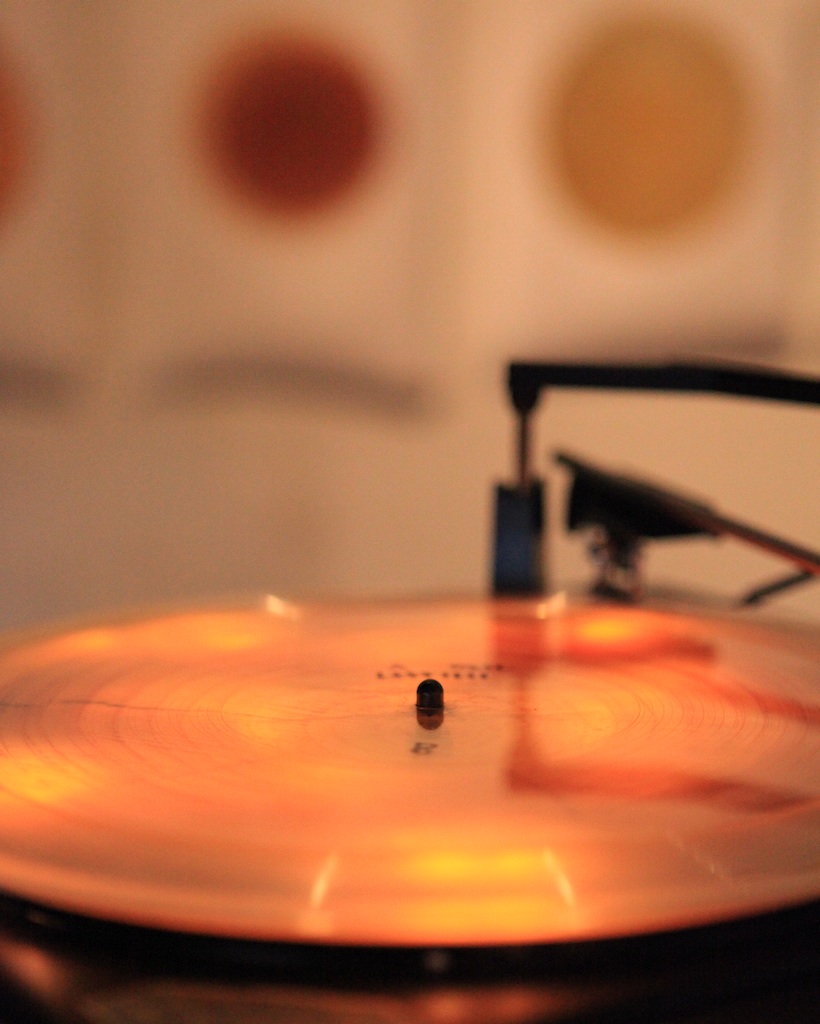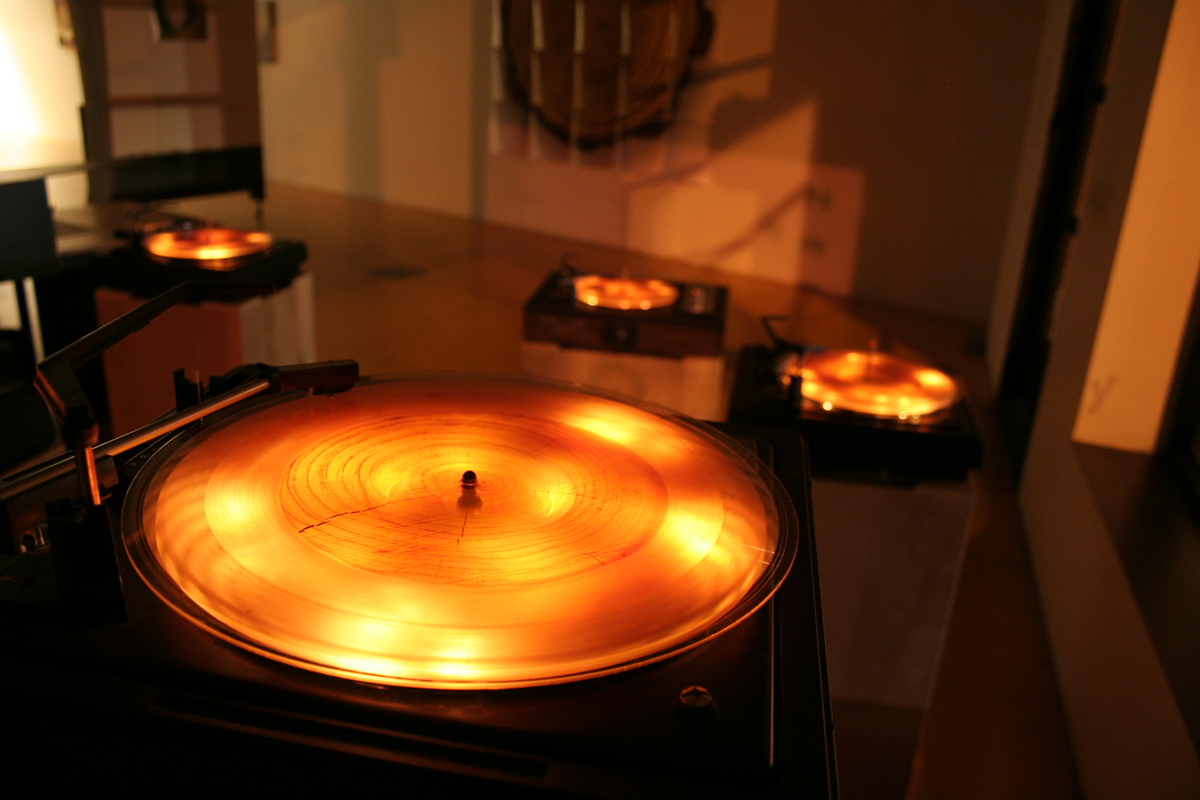Year Without a Summer: 1816
Zeitgeist is pleased to present a mixed media installation from Atlanta-based artist (and Nashville favorite) John Folsom.
A Year Without A Summer 1816 is a sound installation comprised of vinyl recordings played on 7 turntables. Drawing from the notion of traditional landscape painting, the artist provides a soundtrack for that landscape: the sounds of forest creatures, a rushing stream, and wind through trees pressed onto clear vinyl LP records and played continuously.
At the beginning of the 2010 season, the gallery asked artists to elaborate on particular themes in their work in ways that eluded to studio practice and the ideas that lead up to the production of a body of work. John’s latest work parallels how trees record their environment through growth rings and the way sound is etched onto vinyl records. The resulting layers of sound will create an aural landscape recovering the summer that was lost in 1816 due to anomalous climate conditions.
Many associate Folsom with his landscape images incorporating black and white photography and encaustic-pigment layering on large panels. His imagery has traditionally included scenes from Banff (Alberta, Canada), Real Foot Lake (Tennessee), and Massac Creek (Kentucky) recalling Hudson River School painting.
John Folsom’s work can be found public and private permanent collections such as The Fulton County Arts Council in Atlanta, The Christoph Merian Foundation in Basel, Switzerland, and the Tennessee State Museum.
YEAR WITHOUT A SUMMER: 1816 An Aural Landscape in the Classical Tradition
A Year Without A Summer 1816 is a sound installation comprised of vinyl recordings played on 5 turntables. Drawing from the notion of traditional landscape painting, the sounds of forest creatures, a rushing stream, and wind through trees will be pressed onto clear vinyl records and played continuously. I am interested in the parallels between how trees record their environment through growth rings and the way sound is etched onto vinyl records. The resulting layers of sound will create an aural landscape recovering the summer that was lost in 1816 due to anomalous climate conditions.
The Year Without A Summer in 1816 was a period of severe climate abnormality that affected New England, Eastern Canada, Northern Europe and parts of Northern China. During the growing season in New England an early frost killed crops and was followed by two large snowstorms in June that claimed many lives. The resulting famine was catastrophic and widespread. The cause of this climate shift is generally blamed on a weak solar maximum and a major volcanic eruption, phenomena that are still not understood to this day. During this period trees in these parts of the world did not record a growth ring.
This project is an attempt to reconstruct the 1816 summer that never happened and reclaim the lost growth ring. Through the use of five turntables situated on white pedestals of varying height, a makeshift forest will be installed on the floor. Three-minute sound recordings on clear vinyl will play, conveying the sounds of the forest, including summer woodland creatures. On the back of each record, there is an image of a tree ring. The record will be backlit utilizing E-lite flatlight technology. The resulting effect will be a literal idea of glowing tree rings being miraculously played on standard turntables. Turntables will be set to auto so that as the recording cycles the stylus will reset to the beginning of the record creating a continuous, ever-changing tapestry of sound.
The spaces of the forest are a recurring theme in my work and this project brings together many formative memories – both aural and visual. From a young age, forests have held a deep fascination for me. The many family outings to Land Between the Lakes and other regional parks reinforced this connection to the basic elements of wood and light. The visual art that I produce is connected to this sacred idea of the sublime, focusing on the interplay of light, land, and trees. I am interested in the forest as a dynamic living organism and concerned about the ongoing threat from agricultural deforestation. New methods of sustainability must be employed to help protect the natural wonder and vital importance of all forests.
Through a personal exploration of woodland I am increasingly aware of the way in which trees record their environment. Dendrochronology or the study of tree rings, can determine many things from a tree’s age to climate conditions throughout the life of the tree. As trees photosynthesize and grow they record their environment. Rings are formed annually and one ring denotes a year in the life of a tree.
Growing up in a household with a father who was an audiophile gave me a unique perspective on how sound is recorded. My father built many sound systems, designed his own speakers and burned through many styluses in his quest for the perfect turntable. As technology changed, his tastes, and the rest of the worlds, tended toward the perfect vacuum of digital compact discs, leaving the turntable to what seemed an obvious extinction. Through the nostalgic revitalization efforts of many independent bands, vinyl is making a comeback as a novel way to listen to contemporary recordings. Some aficionados even define the difference between listening to analog versus digital as “experiencing” a sound recording rather than just “listening”. Forests serve many functions from protecting and sustaining the diversity of nature to moderating the greenhouse effect. This exhibition seeks to create an environment that reflects potentially obsolete physical phenomena from our natural environment (forests) and from popular culture (vinyl records). Through the use of recognizable vinyl storage medium I hope to draw attention to the idea of what trees can tell us about the history of climate change and our possible future.
date:
October 7 through October 30





